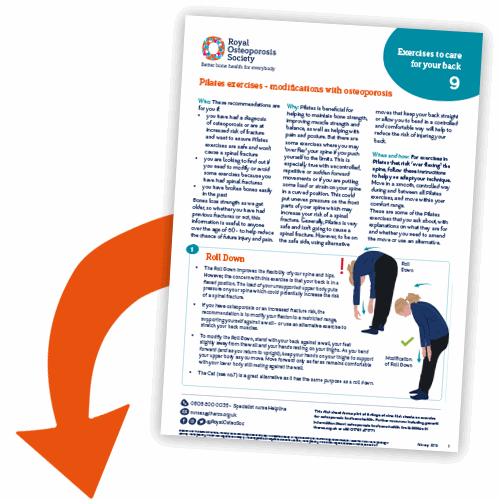
Pilates exercises:
modifications with osteoporosis
Pilates can help to maintain bone strength and improve muscle strength and balance. It can also help with pain and posture. You can practice Pilates if you have osteoporosis. But there are some exercises where you may 'over flex' your spine if you push yourself to the limits. There are some modifications you can make to be on the safe side.
This is especially true with uncontrolled, repetitive or sudden forward movements, or if you are putting some load or strain on your spine in a curved position. This may put uneven pressure on the front parts of your spine, which could increase your risk of a spinal fracture.
Can you do Pilates with osteoporosis?
Generally, Pilates is very safe and won't cause a spinal fracture. However, to be on the safe side, use alternative moves that keep your back straight or allow you to bend in a controlled and comfortable way. This will help to reduce the risk of injuring your back.
To practise these exercises, follow the film or download the accompanying fact sheet, 'Pilates exercises: modifications with osteoporosis'.

Download our fact sheet
Pilates exercises: modifications with osteoporosisThese recommendations are for you if:
- you have osteoporosis or an increased risk of fractures and want to ensure Pilates exercises are safe and won’t cause a spinal fracture
- you want to know if you need to modify or avoid some exercises because you've had spinal fractures
- you have broken bones easily in the past.
Bones lose strength as we get older. This information is useful to anyone over the age of 50, whether or not you've had previous fractures.
When and how
Follow these instructions whenever you're doing Pilates exercises that risk ‘over flexing’ the spine, to help you adapt your technique.
Move in a smooth, controlled way during and between all Pilates exercises, and stay within your comfort range.
Before you start
Read the information in our fact sheet, 'About exercise for osteoporosis and bone health'. This explains the different ways that exercise and physical activity help with bone health and osteoporosis. It can help you think about how the benefits apply to you, and how the different types of exercise can help your bone health.
 Search
Search
 Login
Login


